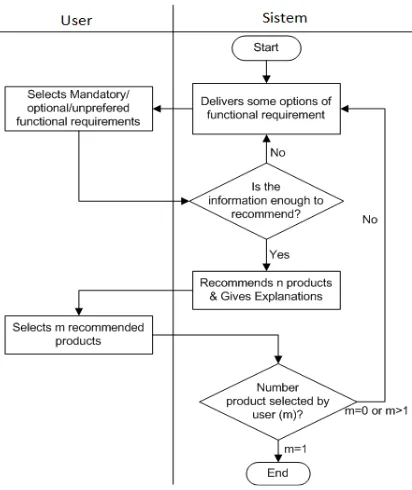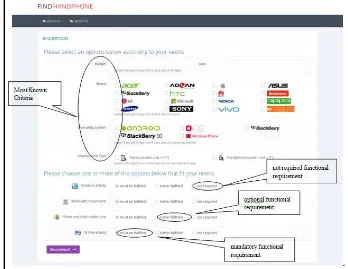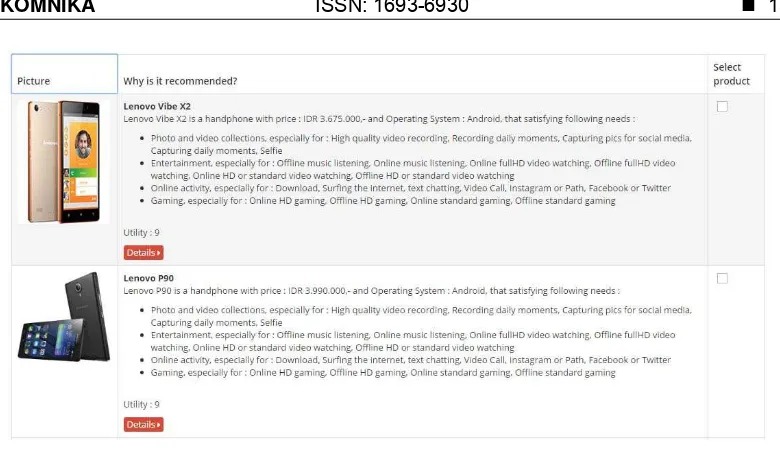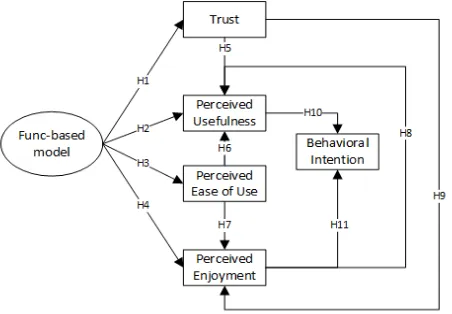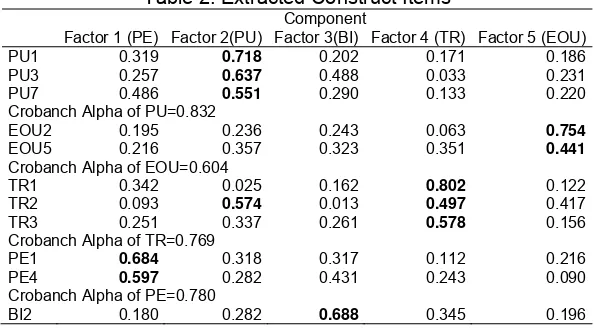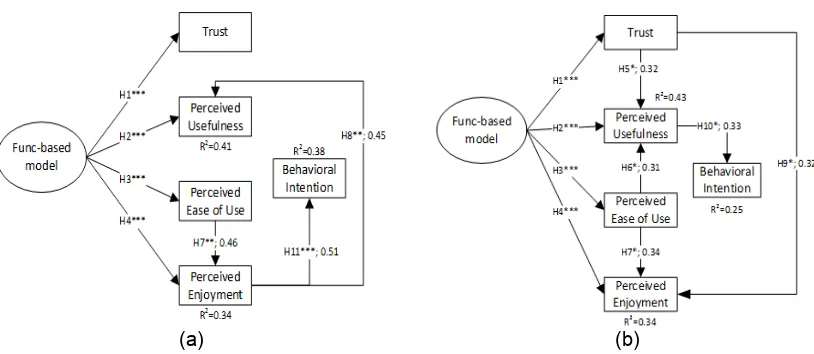DOI: 10.12928/TELKOMNIKA.v14i4.4234 1575
Factors Influencing User’s Adoption of Conversational
Recommender System Based on Product Functional
Requirements
Z.K. Abdurahman Baizal*1, Dwi H. Widyantoro2, Nur Ulfa Maulidevi3
School of Electrical Engineering and Informatics, Institut Teknologi Bandung, Bandung, Indonesia, telp/fax +62-22-250 0935
*Corresponding author, e-mail: [email protected], [email protected], [email protected]
Abstract
Conversational recommender system (CRS) helps customers get products fitted their needs by repeated interaction mechanisms. When customers want to buy products having many and high tech features (e.g., cars, smartphones, notebook, etc.), most users are not familiar with product technical features. The more natural way to elicit customers’ needs is by asking what they really want to use with the product they want (we call as product functional requirements). In this paper, we analyze four factors, e.g., perceived usefulness, perceived ease of use, trust and perceived enjoyment associated to user’s intention to adopt the interaction model (in CRS) based on product functional requirements. Result of experiment using technology acceptance model (TAM) indicates that, for users who aren’t familiar with technical features, perceives usefulness is a main factor influencing users’ adoption. Meanwhile, perceived enjoyment plays a role on user’s intention to adopt this interaction model, for users who are familiar with technical features of product.
Keywords: conversational recommender system, technology acceptance model, online shoping, e-commerce
Copyright © 2016 Universitas Ahmad Dahlan. All rights reserved.
1. Introduction
In most recommender system, user gives some requests, then system gives recommendations, and the session ends. In a real life, a recommendation process in a short session is rare, because most users rarely able to express his real needs at the beginning of interaction, and users are rarely satisfied with initial recommendations [1]. This encourages the emergence of numerous studies on conversational recommender system (CRS) as a system that imitates interaction between customer and professional sales support. CRS allows more than one interaction session (multiple shots). The system recommends products that fit user requirements iteratively through interactions generated by the system.
Recommender system requires a user model for personalizing recommendation. This user model is built by exploring user preference as well as observing of user behavior [2]. CRS can be distinguished by the way of system in building the user model; navigation by asking and navigation by proposing [1]. In navigation by asking (NBA), the system provides a series of questions about user needs [3-5], while in navigation by proposing (NBP), the system suggests certain products to users and obtaining user needs in the form of feedback on the recommended products [6-8].
Interaction models that have been developed ask user preference based on technical features aspects. For high-tech products that have many features, such as notebooks, cars, smartphones, servers, PCs, cameras, etc., many users are not familiar with the technical features of the product. The users more easily express the functional requirements of product that they look for, e.g., need a smartphone for selfies, HD gaming, but not for video recording. Several studies have tried to develop CRSs in which the questions are in the form of product functional requirements, such as FindMe [9] (using NBP) and Advisor Suite [10-13] (exploiting NBA).
are still focused on generating interactions that refers to product technical features. We have introduced a framework that was able to generate interactions based on functional requirements, by combining the NBA and NBP, in our previous research [16]. This paper aims to analyze the influence of interaction model based on product functional requirements on that framework to specific user groups, as well as factors that affect user adoption of this interaction model. We utilize Technology Acceptance Model (TAM) to address it. TAM is a model to explain or predict the user's acceptance and adoption of a new information technologies [17, 18]. At first, this model was developed to describe behavior of users in using computer. The major factors are perceived usefulness and ease of use. We add two factors, perceived enjoyment [19] and trust [20, 21] to our hypotheses model, for analyzing the effect of these two factors. In addition, we also see the influence of interaction model based on product functional requirements to some factors, such as perceived ease of use, perceived usefulness, perceived enjoyment, and trust.
2. Interaction Model
The interaction model covers provision of questions, product recommendations and explanations of why each product is recommended. This interaction aims to explore the user preferences, based on functional requirements of the product. To generate this interaction, sistem requires the mapping of functional requirements - technical features - products. Ontology is a representation of knowledge that appropriate to address this mapping. Interactions are generated by tracing semantic relationships in the ontology. In this paper, we take smartphones as the domain of the CRS. The system utilizes an ontology model as a knowledge base, which consists of three main classes [16]; 1) functional requirements, 2) specification, and 3) product.
Figure 1 illustrates the general scheme of interaction between user and system [16]. At the beginning of the interaction, the system provides multiple options of functional requirements to user. Then, the user can select some functional requirements in the category of mandatory, optional or not required. If the preferences (user requirements) are enough to recommend products, the system provides a list of products that are recommended as well as explanations of why each product is recommended. Meanwhile, if the preference is still too general, the system will deliver more specific questions back to user.
Factors Influencing User’s Adoption of Conversational… (Z.K. Abdurahman Baizal) When the system recommends products, user has opportunity to react to these products. If user selects one product, then interaction is complete. However, if user selects none or more than one product, it indicates that the user is not satisfied with the recommendation. Hence, the system will generate interactions back to help user expresses his needs and make decision.
3. Strategy for Guiding User
During the interaction, user preferences are modeled in a user model. Each interaction step, such as giving questions, product recommendation, or explanation, is generated based on condition of the current user model. To deliver questions, the system will select some nodes of ontology as options to ask. Based on user’s answer, the system will maintain the nodes in user model as a user preference.
3.1. Cases in Interaction Processes
For each interaction step, the system provides at most qmax options of functional requirements (as a question), which can be selected by the user. Based on a survey that was conducted to 35 respondents, the majority of respondents liked qmax=4 (41.94%) followed by qmax=3 (25.81%), 2 (12.90%), 5 (9.68%), more than 6 (6:45%) and 6 (3:23%). Thus, we use qmax=4 in the CRS that we will evaluate. We define five cases that might arise during interaction, which are as follows”
1. Initial interaction (empty user model)
In initial interaction, the system provides questions related to the functional requirements of products that user wants, but still general. Figure 2 gives an example of user interface when the system delivers some initial questions to user. Questions about the budget, brands, operating systems and types of smartphones role as hard constraints, and it generally appear in the user's mind. Functional requirements selected as "must be fulfilled" are elements of the set of mandatory functional requirements, while functional requirements selected as "better fulfilled" is identical to the set of optional functional requirements. The functional requirements selected as "not required" are included in the set of not required functional requirements. The next question (besides the question at the beginning of the interaction) consists of only options of functional requirements.
2. More than one product selected by user
User requirement is still too general, so that the appropriate product is too many. Thus, the system provides more specific questions than the previous ones and potentially desired by user.
3. No recommended product selected by user
When the system provides a list of recommended products, user may like some of these recommended products, and he hesitates to decide one of them. For helping user to make decision, the system will present the differences of functional requirements supported by some of those products.This functional requirements are obtained by looking up the current user preference (mandatory or optional functional requirements) in the user model, and filled by each product. Figure 3 shows an example of the specific functional requirements are supported by Lenovo A536, but are not supported by the two other smartphones (in the same interpretation for Asus Padfone Infinity 2 and Lenovo A8-50). 4. User preferences are still too general
It is possible that user does not like any recommended products. Thus, the system will ask potential functional requirements desired by user, but have not been asked. Questions are generated by searching unexplored user preference nodes in user model.
5. No product that fits user’s preferences (there are contradictory requirements)
Figure 2. Example of Initial Interaction
Figure 3. Example of Comparison of the Specific Functional Requirements of Products Selected by Users
3.2. Product Recommendation and Explanation Facility
The system recommends products based on user preferences that are maintained in the user model. This user model represents the history of user preference elicited during interaction. Mandatory functional requirements act as hard constraints for recommending products. While optional functional requirements are used to determine a degree of conformity of a product with user preference, which is expressed as utility value. More individuals of optional functional requirements are met by a product, the higher utility value of a product. Recommended products are obtained by exploring nodes and its relationships in ontology.
Factors Influencing User’s Adoption of Conversational… (Z.K. Abdurahman Baizal) Figure 4. Example of Recommendation and Explanation Facility Page
4. Framework for Evaluating User’s Perceptions
We apply Technology Acceptance Model (TAM) to analyze the influence of product functional requirements - based interaction model to user's perception, and simultaneously analyze factors that affect user's adoption of this interaction model. In TAM, these factors refer to some constructs, which is also a form of user’s perception of the system. With a hypotheses model, we can analyze the influence between these constructs. The constructs we observed are as follows:
1. Perceived Usefulness (PU): the degree to which user feels that the interaction model is quite useful in resolving problems [17]
2. Perceived ease of use (EOU): the degree to which user feels that using the interaction model will be free of effort [17]
3. Behavioral Intention (BI): the degree to which user intends to use the interaction model in the future, especially for product search [17]
4. Perceived Enjoyment (PE): the degree to which user feels interested, comfortable, and guided by a interaction model offered [19]
5. Trust (TR): the degree to which user trusts the recommendations given by system, where the explanation facility plays a role [20]
Each construct consists of some construct items, which would be a list of questions in questionnaire, as shown in Table 1. Answers of questions 1-23 are encoded on a 5-point Likert scale ranging from I strongly disagree (1), I disagree (2), I Neither agree nor disagree (3), I agree (4) to the I strongly agree (5). For fairness, we randomize the questions 1-23, and these questions are not grouped based on each construct.
4.1. Hypotheses Model
To analyze the influence of interaction model based on product functional requirements (we call as func-based model, for short) in increasing the positive perception of the user, as well as factors that influence user's intention to adopt this interaction model, we define the 11 following hypotheses,
1. H1 : Func-based model increases trust
2. H2 : Func-based model increases perceived usefulness 3. H3 : Func-based model increases ease of use
10. H10 : Perceived usefulness positively affects behavioral intention 11. H11 : Perceived enjoyment positively affects behavioral intention
Table 1. Constructs and Its Items
Code Perceived Usefulness (PU)
PU1 The interaction model improves the quality of product search that I do Zanker, et al [20] PU2 The interaction model offers many benefits over features in the product search
PU3 The interaction model save my time in product search
PU4 The interaction model makes it easier for me to find the best matching product PU5 The interaction model in the system is able to provide better search results PU6 The interaction model is quite helpful in the process of finding product PU7 Overall, the interaction model is very useful in the product search
Perceived ease of use (EOU)
EOU1 System with the interaction model is easy to use J. Brooke[22] EOU2 This interaction model does not require a lot of effort
EOU3 I think the interaction model will also be easy to use for others EOU4 Each step of interaction is quite clear and easy to understand EOU5 It is easy for me to be sklillful at using this interaction model
Trust (TR)
TR1 I believe with the products recommended by the system with this interaction model
Zanker, et al [20]
TR2 I believe the explanation given by the interaction model, about why each product is recommended
TR3 I believe that the order of recommended products list is consistent with my needs TR4 The explanation given by system leads me to believe that the recommended
products are suitable to my needs
Perceived Enjoyment (PE)
PE1 The interaction model is quite interesting Liao, et al [19] PE2 I feel comfortable with the interaction in these systems
PE3 The process of interaction in the system is quite pleasant PE4 Interactions in this system makes me feel guided
Behavioral Intention (BI)
BI1 If i have access to this system sometime in the future, I intend to use this system for product search
Liao, et al [19]
BI2 I will use the system with this interaction model in the future BI3 I would recommend this system to others
Figure 5 depicts this hypotheses model. Zanker [20] have proved that the explanation facility on recommender systems can improve the perceived usefulness, perceived ease of use and trust. In this paper, we try to evaluate the influence of func-based model to increasing of the perceived usefulness, perceived ease of use, trust and perceived enjoyment (Hypotheses H1 - H4). Some studies have reported the positive influence between trust and perceived usefulness [21-24], so we also evaluate the effect between these two constructs (H5). Perceived usefulness, perceived ease of use and behavioral intention, being the core constructs in TAM, and their relationship is the most widely studied in TAM studies, since introduced by Davis [17].
Factors Influencing User’s Adoption of Conversational… (Z.K. Abdurahman Baizal) Thus we make hypotheses H6 and H10, to evaluate the relationship between these three constructs. Perceived enjoyment has a crucial influence on customer intention and behavior, in the area of e-commerce [23], [25-26]. Therefore also involve perceived enjoyment in our hypotheses model (hypotheses H7, H8, H9 and H11).
To test H1 - H4, we involve 100 users who are grouped in categories familiar (48%) and unfamiliar (52%) with the technical features of the product. The user’s age ranged between 18-55 years. They were smartphone users and familiar with web-based application. Each user tries to use two kinds of interaction model; 1) functional requirements-based interaction model we have developed, 2) flat model (for comparison). Flat model is an interaction model based on the technical features of the product is commonly found in e-commerce web sites. For fairness, both systems have the same product data and identical user interfaces, while the difference only in coping strategies of each interaction case. After using two different kinds of interaction model, users are asked to answer the questions in questionnaire. To evaluate H5-H11, we just focus on the user’s answers of func-based model and apply linear regression analysis by the following formula:
a=constant, = random error, bi=coefficient (index i corresponds to hipothesis ith in hypotheses
model)
4.2. Validity and Reliability Testing
In a first step, we do the validity testing on 23 construct items presented to respondents. By using principal components extraction (varimax rotation method with Kaiser Normalization), 23 construct items are reduced to 11 items, as presented in Table 2. Each resulting factor corresponds to each construct. However, TR2 is also highly correlated with factor PU, as question TR2 also can be interpreted to support PU. Subiyakto, et al [27] and Zanker [20] noted that the factor loadings larger than 0.40 are quite understandable and acceptable to form the underlying scale in the factor analysis. As seen in Table 2, all factor loadings are higher than 0.40. The result of reliability testing is represented by value of Cronbach Alpha of each construct. O’Rourke [28] noted that Cronbach Alpha value of 0.50 or greater is sufficient for research, while 0.70 is recommended and 0.80 is desirable. As it can be seen from Table 2, all Cronbach Alpha values are greater than 0.60, even mostly above 0.70 and 0.80.
Table 2. Extracted Construct Items Component
Factor 1 (PE) Factor 2(PU) Factor 3(BI) Factor 4 (TR) Factor 5 (EOU)
PU1 0.319 0.718 0.202 0.171 0.186
PU3 0.257 0.637 0.488 0.033 0.231
PU7 0.486 0.551 0.290 0.133 0.220
Crobanch Alpha of PU=0.832
EOU2 0.195 0.236 0.243 0.063 0.754
EOU5 0.216 0.357 0.323 0.351 0.441
5. Results
5.1. Influence of Functional based Interaction on User’s Perception
As seen in Table 3, for users who are familiar with the technical features, the average of the rates for func-based model is greater than the flat model, especially for factors perceived usefulness, perceived ease of use, trust and perceived enjoyment. To evaluate the significance of the mean difference, we used T-test, and also involves Levene's test for equality of variances. T-test results in Table 3 show that, func-based model influences significantly to increase user's perception of these four factors (p <0.001). It suggests that H1, H2, H3 and H4 are accepted. From Table 3 we can notice that the user’s rate average for the func-based model is significantly higher than the flat model, for these four factors.
Table 3. Mean of Rates and T-Testing Results
Factor Model
T-test proved that the average of user’s rates is significantly different for these four factors, such that H1, H2, H3 and H4 are accepted (with significance level = 0.001). It can be concluded that func-based model can improve user’s perceptions (perceived usefulness (PU), perceived ease of use (EOU), trust (TR) and perceived enjoyment (PE)), for both users who are familiar and unfamiliar with technical features of product.
5.2. Factors Influencing User's Intention to Adopt the Product Functional Requirements-Based Interaction Model
We apply a linear regression analysis to evaluate the effects of among factors and analyze factors influencing adoption of this func-based model. The analysis is represented by hypotheses H5 - H11. First, we analyze the path of hypotheses testing based on the user’s perception, regardless of the user categories. To evaluate the goodnes of fit of our hypotheses model to data, we use some model-fit indices resulted by LISREL path analysis. Liao, et al [19] note that the bounds of model fit indices that indicate the good fit to the data are GFI > 0.8, RMSEA < 0.08. Meanwhile, Al-Maghrabi, et al., [23] note that chi square/df ≤ 5 represents good model-fit. The results reveal that the chi-square/degrees of freedom (CMIN/DF) is 1.58, goodness of fit index (GFI) is 0.93, and root mean square error of approximate (RMSEA) is 0.076. The results confirm that the hypotheses model fit the data reasonably well.
Factors Influencing User’s Adoption of Conversational… (Z.K. Abdurahman Baizal) perceived usefulness, 34 percent for perceived enjoyment and 23 percent for behavioral intention.
Figure 6. Paths of Accepted Hypotheses of Whole Users
(a) (b)
* : significant with p < 0.05; ** : significant with p < 0.01; *** : significant with p < 0.001
Figure 7 (a). Paths of Accepted Hypotheses of Users who are Familiar with Technical Features (b). Paths of Accepted Hypotheses of Users who are not Familiar with Technical Features
Paths of accepted hypotheses of users who are familiar with technical features are depicted by pictures 7(a). Model-fit indices of this hypotheses model are, CMIN/DF=0.93, RMSEA=0.00, and GFI=0.961. The result shows that the hypotheses model fit to the data. As seen in Figure 7(a), perceived ease of use greatly affects the perceived enjoyment (H7). This means that the ease presented by func-based model really makes users feel interested and guided (perceived enjoyment). Meanwhile, perceived enjoyment is influenced by perceived enjoyment (H8), and perceived usefulness influence the behavioral intention (H10). The results of hypotheses testing show that users who are familiar with the technical features, intend to adopt this interaction model due to (indirectly) its ease and ability to guide the user (enjoyment). However, trust and perceived usefulness are not factors that affect user's intention of adopting this interaction model. Interaction based on the functional requirements of a product is not so attractive for users in this category, because they are already familiar with the technical features of the product. However, these users feel guided by all of interactions, such that they intend to use this interaction model in the future (behavioral intention).
results show that perceived ease of use and trust affect the perceived usefulness (accept H5 and H6) and the perceived usefulness influence behavioral intention (accept H9). Hence, users feel that the interaction model is useful due to the ease and trust. Both of these factors indirectly affect users’ intention to adopt the interaction model (in CRS) in the future. Furthermore, the explanation facility based on functional requirements is enough to help users in product search. In addition, trust and perceived ease of use influence the perceived enjoyment (accept H7 and H9). Thus, the explanation facility and ease of use in this interaction make the users feel guided (perceived enjoyment).
7. Conclusion
In experiments, we involve two categories of users as respondents; 1) users who are familiar with the product technical features of product, 2) users who are not familiar with the product technical features of product. The result shows that interaction model (in CRS) based on product functional requirements is able to increase the perceived ease of use, perceived enjoyment, trust and perceived usefulness for both user’s categories. Overall (regardless of the category of user), the users feel interested and guided (perceived enjoyment) because of perceived ease of use and also the trust that comes from interactions and explanations. On the other hand, perceived ease of use, trust and perceived enjoyment affect perceived usefulness, and indirectly affect user’s intention to adopt the functional requirements-based interaction model. However, we can notice that perceived enjoyment is stronger influencing factor of user’s intention to adopting the interaction model relative to perceived usefulness.
If we look at the user’s perception of each user category, there are some difference results between these two categories. For users who are familiar with the technical features of the product, trust is not a factor affecting user adoption to the model. Since they are already familiar with the technical features, explanation facility based on the functional requirements is not attractive. The interesting thing is, users feel comfortable and guided (perceived enjoyment) due to ease of use offered by product functional requirements-based interaction model. We notice that perceived enjoyment is a factor influencing user’s adoption on the interaction model instead of perceived usefulness.
For users who are not familiar with the technical features of the product, trust and ease of use plays a role for the adoption of product functional requirements-based interaction model, indirectly. All of interaction processes (with 5 cases addressed by interaction model in CRS) as well as explanation facility, make users feel that the interaction model is useful and very helpful, so the users will adopt this interaction model (CRS) in the future for product search. The interesting thing is, perceived enjoyment is not a factor affecting user’s adoption of the model of interaction. Although the users feel more comfortable and guided by functional requirements-based interaction model than the flat model (H4), but it is not a factor that affects the users to adopt a functional-based interaction model.
References
[1] Bridge D, Goker MH, McGinty L, Smyth B. Case-Based Recommender Systems. The Knowledge Engineering Review. 2006; 20(3): 315-320.
[2] Zanker M, Jessenitschnig M. Case-Studies on Exploiting Explicit Customer Requirements in Recommender Systems. User Modeling and User-Adapted Interaction. 2009; 19(1-2): 133-166. [3] Doyle M, Cunningham P. A Dynamic Approach to Reducing Dialog in On-Line Decision Guides. The
5th European Workshop on Case-Based Reasoning. 2000: 49-60.
[4] Schmitt S, Dopichaj P, Domínguez-Marín P. Entropy-Based Vs. Similarity-Influenced: Attribute Selection Methods for Dialogs Tested on Different Electronic Commerce Domains. The 6th European Workshop on Case-Based Reasoning. 2002: 380-394
[5] Gu M, Aamodt A, Explanation-Boosted Question Selection in Conversational CBR. Workshop on Explanation in CBR. Madrid. 2004: 105-114.
[6] McGinty L, Reilly J. On The Evolution Of Critiquing Recommenders. In: Recommender Systems Handbook. Springer US. 2011: 419-453.
[7] Smyth B, McGinty L, Reilly J, McCarthy K. Compound Critiques for Conversational Recommender Systems. EE/WIC/ACM International Conference on Web Intelligence. 2004: 145-151.
Factors Influencing User’s Adoption of Conversational… (Z.K. Abdurahman Baizal)
[9] Burke K, Hammond K, Young B. The FindMe Approach to Assistive Browsing. IEEE Expert. 1997; 12(4): 32-40.
[10] Jannach D. Advisor Suite - A Knowledge-Based Sales Advisory System. The 16th European Conference on Artificial Intelligence - Prestigious Applications of AI (PAIS). 2004: 720-724.
[11] Jannach D, Kreutler G. A Knowledge-Based Framework for the Rapid Development of Conversational Recommenders. The 5th International Conference of Web Information System. 2004: 390-402.
[12] Jannach D, Zanker M. Developing a Conversational Travel Advisor with Advisor Suite. Information and Communication Technologies in Tourism. 2007: 43-52.
[13] Felfernig A, Friedrich G, Jannach D, Zanker M. An Integrated Environment for the Development of Knowledge-Based Recommender Applications. International Journal of Electronic Commerce. 2006; 11(2): 11-34.
[14] Shimazu H. ExpertClerk: A Conversational Case-Based Reasoning Tool for Developing Salesclerk Agents in E-Commerce Webshops. Artificial Intelligence Review. 2002: 18(3–4): 223-244.
[15] Hu B, Aufaure MA. A Query Refinement Mechanism for Mobile Conversational Search in Smart Environments. Proceedings of the IUI 2013 on Second Workshop on Interacting with Smart Objects. 2013: 1-6.
[16] Widyantoro DH, Baizal ZKA. A Framework of Conversational Recommender System Based On User Functional Requirements. The 2nd International Conference on Information and Communication Technology (ICoICT). 2014: 160-165.
[17] Davis FD, Bagozzi RP, Warshaw PR. User Acceptance of Computer Technology: A Comparison of Two Theoretical Models. Management Science. 1989; 35(8): 982-1003.
[18] Davis FD, User Acceptance of Information Technology: System Characteristics, User Perceptions and Behavioral Impacts. International Journal of Man-Machine Studies. 1993; 38(3): 475-487.
[19] Liao CH, Tsou CW, Shu Y. The Roles of Perceived Enjoyment and Price Perception in Determining Acceptance of Multimedia-On-Demand. International Journal of Business and Information. 2008; 3(1): 27-52.
[20] Zanker M. The Influence of Knowledgeable Explanations on Users’ Perception of A Recommender System. Proceedings of the sixth ACM conference on Recommender systems. 2012: 269-272. [21] Pavlou PA. Consumer Acceptance of Electronic Commerce: Integrating Trust and Risk with the
Technology Acceptance Model. International journal of electronic commerce. 2003; 7(3): 69-103. [22] Brooke J. SUS: A Quick and Dirty Usability Scale. In: Usability Evaluation in Industry. Taylor &
Francis. 1996: 189-194.
[23] Al-Maghrabi T, Dennis C, Halliday SV, BinAli A. Determinants of Customer Continuance Intention of Online Shopping. International Journal of Business Science and Applied Management. 2011; 6(1): 41-65.
[24] Wu K, Zhao Y, Zhu Q, Tan X, Zheng H. A Meta-Analysis of the Impact of Trust on Technology Acceptance Model: Investigation of Moderating Influence of Subject and Context Type. International Journal of Information Management. 2011; 31(6): 572-581.
[25] Koufaris M. Applying the Technology Acceptance Model and Flow Theory to Online Consumer Behavior. Information Systems Research. 2002; 13(2): 205-223.
[26] Wen C, Prybutok VR, Xu C. An Integrated Model for Customer Online Repurchase Intention. Journal of Computer Information Systems. 2011; 52(1): 14-23.
[27] Subiyakto A, Ahlan AR, Kartiwi M, Sukmana HT. Influences of the Input Factors towards Success of an Information System Project. TELKOMNIKA Telecommunication Computing Electronics and Control. 2015; 13(2): 686.
